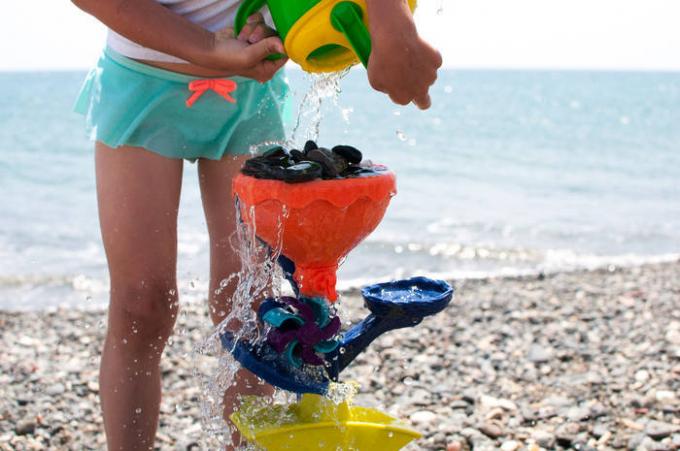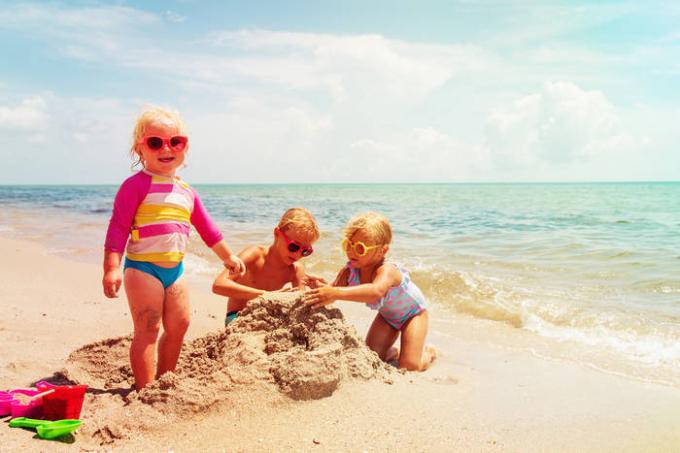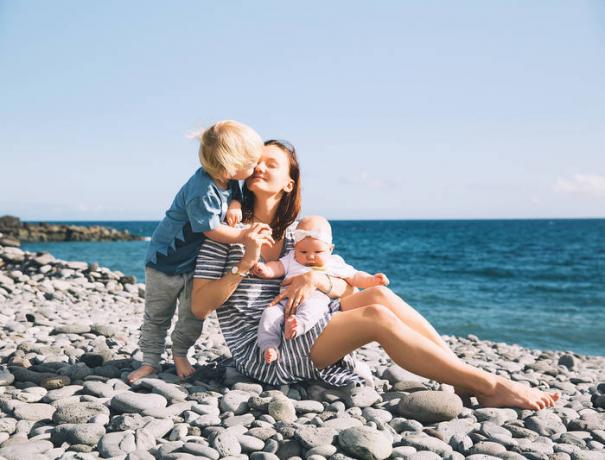Natural toys: everything is simple! Stones, water, sand - excellent educational materials. And in the country they literally lie under our feet. Let's use?
Summer - it's a leisure trip, observing nature, playing outdoors and the sea of good mood! child leisure summer can be arranged not only entertaining, but also informative. And it does not need to invent anything special, because nature has already done everything for us.
Operating properties of water
Playing with water to help your child not only mentally and physically develop, but also to learn a new environment. Raskazhite child that water - liquid substance takes the form of the vessel in which is transparent, odorless and tasteless.
1. Sinks - does not sink!
We study the properties of water to keep on the surface light materials. Take a basin of water and a few items that sink in water (stone, acorn), as well as a few that do not sink (flat leaf, birch seed). Ask the kid how he thinks, what items will sink and which will remain on the surface? Then asked to verify his suspicions, dropping various objects in the water.
2. Perelivayka
Learning the manipulation of liquid substances. Various methods offer the baby transfusion water: from large to small dishes, from small to large, pour water into the bowl with a narrow neck and wide, through a strainer, the chute.

Playing with children on a beach: pebbles, sand, water / istockphoto.com
3. Fishing
Develop agility and speed of reaction. You will need a large bowl with water and items that do not sink in water, such as plastic caps from bottles, as well as a small net or ladle with a long handle. Have your child catch of the "pond" of all fish using only a "bait." It is also possible to arrange a competition who catch many fish.
4. Who is faster?
Develop agility, reaction time, the spirit of competition. For the game will need: 2 small cups, two identical buckets, 1 basin with water. This game is a competition to see who will fill his bucket with water, scooping a small glass of water.

Playing with children on a beach: pebbles, sand, water / istockphoto.com
5. color Vodicka
We develop thinking, teach, conduct experiments, show your child how the water is painted in different colors. For this experiment will need transparent cups or jars, clean water, paint of different colors. In all the glasses, pour the water, and then in each dripping paint of different colors, mix in a glass of water and watch what color was the water lapped.
6. wisp
Developing fine motor skills hand coordination. Suggest baby container filled with water, omitting the water and the sponge pressing it into the bucket. You can also compete and who will make it happen.
7. underwater treasures
Develop tactile sensation, motor skills of hands, imagination. Type in a basin of water, tying the baby's eyes, and in the basin throw various objects. The child must catch the objects out of the water and examining their hands to call, that he caught.
What are you, the sand?
Operating properties of sand - loose, friable, it becomes more dense form, from which it is possible to mold in contact with water.
1. Fill molds
Develop agility, motor skills of hands, coordination of movements. We are looking for 2 players, each given the same amount of sand molds for (you can use any other capacity). The task is to fill all the molds before the opponent.
2. We unearth a treasure
Develop imagination, dexterity and wit. Ask your child to look away or time away from the sandbox, standing back to her. Dig in the sand a few small items. The kid has to find all the items guided by adult prompts.
3. Drawing on the sand
Develop visual skills, imagination.
Fill a shallow pan or tray of sand and create your masterpiece with the baby. You can draw fingers or thin twigs.
4. Guess Next
Develop thinking, imagination, logic. As long as the kid does not see, leave footprints on the sand of various objects (molds). Ask guess what imprint, what corresponds to the subject.
5. Peresypalochki
Develop motor skills of hands, coordination of movements. We need to take a number of different shaped vessels (a bucket, molds, plastic bottle, jar with a wide neck). Peppered with sand at a time in each container, and observe that the sand takes the shape of the vessel in which he was.

Playing with children on a beach: pebbles, sand, water / istockphoto.com
strong stones
We study the properties of stones - hard, durable material that has different sizes and shapes.
1. Hit the target
Stage 1 - we take a hoop, put it on the ground, the child moves into five steps back, and this distance throwing pebbles into the hoop.
Stage 2 - instead of a hoop set is not large basin, from a distance of five steps, trying to get the baby pebbles in a bowl.
Stage 3 (the most difficult) - Basin replace children's bucket. And also from a distance of five steps, trying to throw stones at the target.
2. colorful mosaic
From a stone you can not do with plain colored mosaic. To do this, stones are about the same size, color the colored gouache.
When they dry out you can spread them surprising patterns.
3. Count the stones
Take a few molds, place them in a row and have the baby put in each mold a certain amount of stones. When all the stones will be laid out, ask the child to count how many pebbles to be in a particular mold.
4. song stones
A stone turns out to be able to "sing", or rather, to issue certain sounds. Fill the plastic bottle stones, somewhere halfway and shake it strongly. By the way small stones emit some sounds, and more - other.
If you combine all these natural materials, water soaking the sand, build a castle, a stone fence and lay track, you get no less fascinating and cognitive game!
Also, you will be useful to read: live applications from scrap materials




